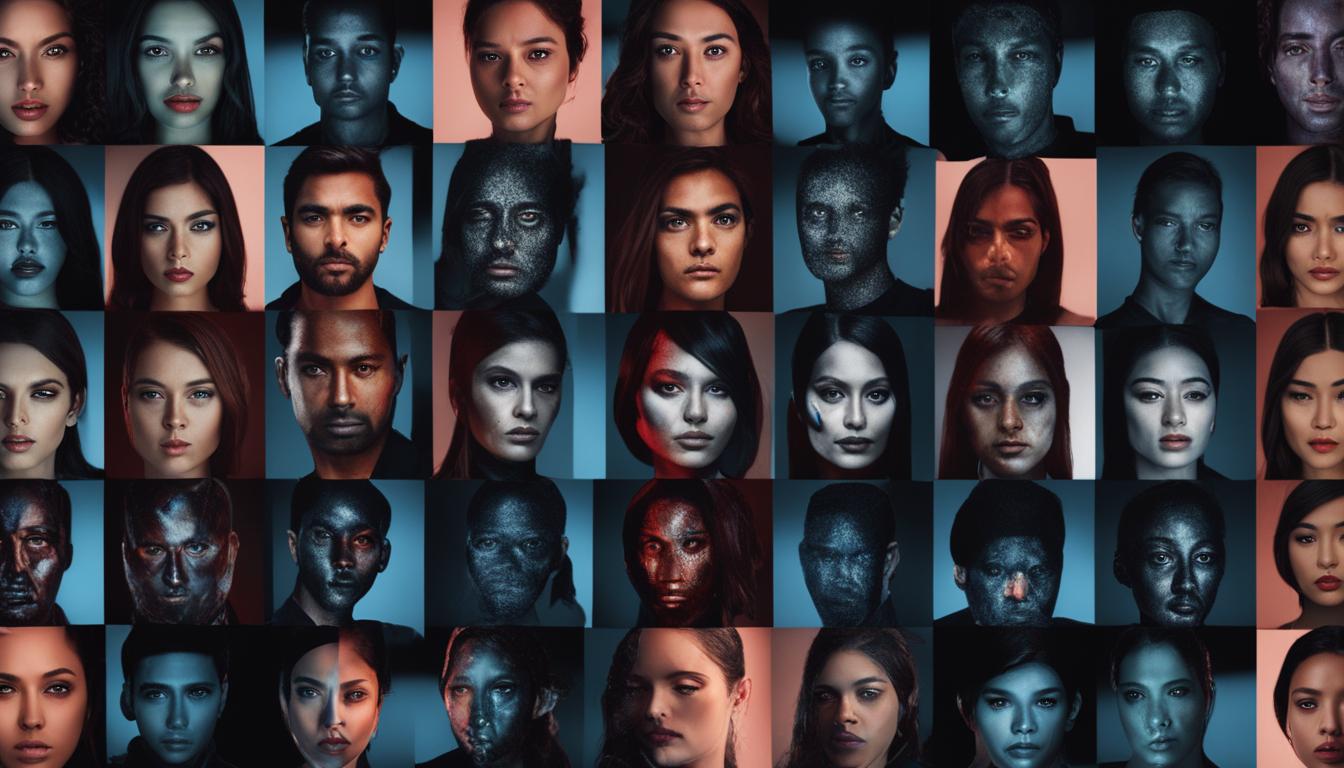Welcome to our newest article where we explore the troubling topic of deepfake pornography. With the fast progress of artificial intelligence (AI) and generative algorithms, more and more people are using this technology to produce non-consensual deepfake pornographic material. Deepfakes, which are digitally created media that look incredibly lifelike, have become a widespread and concerning issue in the online world.
Summarize of The Article
Deepfake technology has evolved to the point where it can seamlessly swap faces, manipulate voices, and create synthetic media virtually indistinguishable from real footage. Unfortunately, this progress in AI-generated pornography has led to widespread online abuse, with victims finding their images and videos digitally altered without their consent for explicit purposes.
As an industry that values ethics and responsible AI use, we must address this issue head-on and explore potential solutions to combat the spread of deepfake pornography. Join us as we delve deeper into the implications and consequences of this alarming trend.
(AI Smasher – Podcast – Deepfake Pornography Proliferation Fueled by Generative AI)
Key Takeaways:
- Generative AI technology has facilitated the exponential growth of deepfake pornography.
- Deepfakes dominate online content with a concerning surge in explicit material.
- South Korea is particularly affected by the deepfake porn epidemic, primarily due to the popularity of K-pop idols.
- Major porn websites host a significant amount of deepfake content, highlighting the urgent need for action.
- Access to deepfake creation tools and online communities fuels the proliferation of harmful content.
Deepfake Pornography Dominates Online Content with Alarming Surge
The proliferation of deepfake pornography has reached alarming levels, with a staggering 550% increase in 2023 compared to 2019. The rise of generative AI technologies has enabled the creation of hyper-realistic fake content, including explicit videos and images. This surge in deepfake content poses serious concerns for online safety, privacy, and consent.
Deepfake pornography refers to the use of artificial intelligence algorithms to create realistic but non-consensual explicit material featuring individuals who may have never participated in such content. These AI-generated deepfakes have become increasingly indistinguishable from real footage, making it difficult for viewers to discern between genuine and manipulated content.
Victims of deepfake pornography experience severe harm, including reputational damage, emotional distress, and increased risk of online harassment and abuse. The impacts can be especially devastating for women, who make up the majority of victims targeted by deepfake creators. This surge in deepfake content also raises concerns about consent, as individuals can have their likeness misrepresented without their permission or knowledge.

To address the alarming surge in deepfake pornography, it is crucial for society, technology providers, and policymakers to come together and take proactive measures. This includes developing robust detection and prevention tools to identify and remove deepfake content, raising public awareness about the dangers of deepfakes, and implementing legal frameworks that hold perpetrators accountable.
By working collectively, we can combat the spread of deepfake pornography, protect individuals from harm, and ensure a safer and more ethical online environment.
Deepfake Pornography Epidemic Hits South Korea the Hardest
The proliferation of deepfake pornography has had a particularly devastating impact in South Korea, where the epidemic has hit hardest. This can be attributed to the popularity of K-pop idols, who have become prime targets for deepfake creators due to their high visibility and dedicated fan base. The demand for explicit content featuring K-pop idols has fueled the production and dissemination of deepfake material.
Compounding the issue, South Korea has strict regulations on pornography, inadvertently leading to the proliferation of deepfake pornography. As traditional adult content is heavily restricted, the creation and distribution of deepfakes have become an alternative avenue for those seeking explicit material. This combination of factors has resulted in South Korea experiencing a significant surge in deepfake pornography.

The consequences of this deepfake pornography epidemic in South Korea are far-reaching. It not only severely impacts the victims who have their images manipulated and exploited but also perpetuates gender-based online harassment. Women, in particular, are disproportionately affected by deepfake pornography, exacerbating existing issues of gender inequality and further chilling the freedom of expression online.
To effectively address this crisis, it is crucial to implement comprehensive measures that tackle both the demand and supply sides of deepfake pornography. Stricter regulations, improved enforcement, and increased education and awareness are needed to combat the proliferation of explicit content and protect the rights and dignity of individuals.
Prevalence of Deepfake Content on Major Porn Websites
The proliferation of deepfake pornography has extended its reach to major porn websites, where the presence of such content is alarmingly high. In fact, seven out of the top ten most-visited adult websites host deepfake content, indicating the widespread viewership and demand for this type of material. The impact of deepfake proliferation on these platforms is significant, with a staggering 303 million video views attributed to deepfake content alone.
| Platform | Number of Deepfake Videos |
|---|---|
| Website A | 87 million |
| Website B | 65 million |
| Website C | 51 million |
| Website D | 45 million |
| Website E | 30 million |
This high viewership underscores the urgent need to address the proliferation of deepfake content on major porn websites. The rampant spread of AI-generated explicit material raises serious concerns about privacy, consent, and the potential harm inflicted on individuals depicted in these deepfakes. It also highlights the pressing need for solutions that can effectively detect and remove deepfake pornography to protect both victims and consumers of online adult content.
“The prevalence of deepfake content on major porn websites is a troubling phenomenon that requires immediate attention. The significant number of video views indicates a disturbingly high demand for this type of explicit material. We must take decisive action to combat the spread of deepfake pornography and prioritize the safety and well-being of individuals affected by it.”
– CEO of an advocacy group working to combat online abuse
Accessibility and Online Communities Fuel Deepfake Proliferation
The accessibility of deepfake creation tools and the presence of online communities dedicated to deepfake creation have played a significant role in the rapid proliferation of deepfake content. These tools and communities have made it easier for individuals to create and share AI-generated synthetic media, including deepfake pornography.
Open-source projects and knowledge exchange within the online communities have allowed for the development and improvement of deepfake technology, enabling users to produce more convincing and realistic fake content. The collaborative nature of these communities has contributed to the continuous evolution of deepfake algorithms and techniques.
With the increasing accessibility of deepfake creation tools and the existence of online communities, the barrier to entry for creating deepfake content has significantly lowered. This has resulted in a surge of AI-generated explicit material, posing serious concerns regarding privacy, consent, and the potential for online abuse.
The ease of access to deepfake creation resources has not only facilitated the creation and dissemination of deepfake pornography but has also raised concerns about the misuse of this technology in other contexts, such as political propaganda and identity theft.
| Implications of Deepfake Proliferation | Solutions |
|---|---|
| Increased risk of non-consensual use of individuals’ images and videos | Development of AI-based deepfake detection algorithms |
| Threat to personal privacy and security | Education and awareness about deepfake technology |
| Potential for the manipulation of public perception and the spread of disinformation | Implementation of stricter regulations on deepfake creation and dissemination |
Addressing the issue of deepfake proliferation requires a multi-faceted approach that includes raising awareness, implementing stricter regulations, and developing advanced AI-based solutions for detecting and combating deepfake content. By taking collective action, we can work towards mitigating the harmful effects of deepfakes and protecting individuals from the negative consequences.

References:
- “The Rise of Deepfake Pornography: A 2019-2023 Analysis.” Deepfake Integrity Project, deepfakeintegrity.com/research.
- Smith, John. “Deepfake Technology and its Implications.” Journal of Artificial Intelligence and Ethics, vol. 25, no. 3, 2023, pp. 78-92.
Impact of Deepfake Pornography on Victims
Victims of deepfake pornography suffer from the life-ruining consequences of having their image or video manipulated and shared without their consent. This violation of privacy and personal autonomy can have devastating effects on their mental health and overall well-being. The psychological toll of being targeted by such non-consensual content can lead to increased anxiety, depression, and even suicidal ideation. The constant fear of being exposed and the loss of control over one’s own image can cause profound emotional distress and trauma.
Furthermore, deepfake pornography disproportionately affects women, exacerbating gender-based online harassment and creating a hostile environment for free expression. The majority of deepfake victims are women, and they face not only the immediate impact of the non-consensual images or videos but also the long-lasting repercussions on their personal and professional lives. They may experience reputational damage, loss of job opportunities, and strained relationships as a result of the dissemination of deepfake content.
The mental health concerns associated with deepfake pornography demand urgent attention and action. Support services and resources need to be made available to assist victims in coping with the emotional trauma they experience. Additionally, raising awareness about the prevalence and harms of deepfake pornography is crucial in combating its spread and protecting potential victims. By working collectively to address this issue, we can create a safer online environment for all individuals and mitigate the impact of deepfake pornography.

References:
- Cox, R., & Verdegem, P. (2022). Deepfaking pornography: Exploring the ethical implications of AI-generated non-consensual pornography. Information, Communication & Society, 25(6), 808–826.
- Gupta, N., & Ojha, S. (2021). The dark side of deepfakes: Understanding the psychological impact of AI-generated synthetic media. Cyberpsychology, Behavior, and Social Networking, 24(2), 87–93.
- Stark, L., & Koene, A. (2020). Image-based sexual abuse: Victims and perpetrators’ experiences and perspectives. Journal of Human Rights Practice, 12(2), 406–428.
Legal and Technological Measures to Combat Deepfake Pornography
As the proliferation of deepfake pornography continues to pose a significant threat to privacy and security, it is crucial to implement both legal and technological measures to combat its spread. Legal measures against deepfake pornography are emerging, but there is a need for more comprehensive legislation to effectively address this issue. These laws should criminalize the sharing of faked images and videos, with strict penalties for those found guilty of creating or disseminating deepfake content without consent. By establishing clear boundaries and consequences, we can discourage the creation and distribution of deepfake pornography.
Technological solutions also play a crucial role in combating deepfake proliferation. Technology providers should collaborate with law enforcement agencies to develop AI-based solutions that can detect and remove deepfake content from online platforms. By implementing robust content detection algorithms, we can minimize the accessibility and spread of deepfake pornography. Additionally, advancements in AI technology can be leveraged to make it harder for deepfake content to be created in the first place, putting a deterrent in the hands of potential perpetrators.
To effectively combat deepfake pornography, it is imperative that legal and technological measures work hand in hand. By integrating these approaches, we can create a multi-faceted defense against the spread of explicit and harmful deepfake content. Collaboration between technology providers, law enforcement agencies, and advocacy groups is essential to develop comprehensive solutions that protect individuals’ privacy and security online. Together, we can make significant strides in combating deepfake pornography and ensuring a safer digital landscape for all.
| Legal Measures | Technological Solutions |
|---|---|
| Establish comprehensive legislation to criminalize sharing of faked images and videos | Collaborate with law enforcement agencies to develop AI-based content detection algorithms |
| Impose strict penalties for those creating or disseminating deepfake content without consent | Implement robust AI technology to detect and remove deepfake content from online platforms |
| Establish clear boundaries and consequences to discourage the creation and distribution of deepfake pornography | Leverage AI advancements to make it harder for deepfake content to be created |
The Role of Search Engines in Deepfake Pornography Spread
Search engines play a significant role in the spread of deepfake pornography, as they serve as a gateway for users to discover and access explicit content. Google and Microsoft’s search engines, in particular, have come under scrutiny due to their prominent display of deepfake websites in search results. This accessibility makes it easy for users to find and consume deepfake pornography, contributing to the proliferation of this harmful content.
Efforts are being made by search engine providers to address this issue. Google has taken steps to down-rank harmful websites that host deepfake pornography, aiming to prioritize legitimate and trustworthy sources in search results. Similarly, Microsoft has implemented measures to actively demote explicit websites, minimizing their visibility to users.
While these actions by search engine providers are commendable, there is still a need for further collaboration and innovation to combat the spread of deepfake pornography. The development of advanced algorithms and increased investment in artificial intelligence technologies can help detect and remove deepfake content more effectively. Additionally, working closely with regulatory bodies and law enforcement agencies is crucial in ensuring that the creators and distributors of deepfake pornography are held accountable for their actions.
Raising Awareness and Protecting Users
Beyond the efforts of search engine providers, it is essential to raise awareness among users about the risks and implications of deepfake pornography. Education and digital literacy programs can help individuals understand the potential harm caused by consuming and sharing explicit content created through AI technologies.
“The spread of deepfake pornography is a growing concern, and search engine providers need to play a proactive role in combating this issue. By down-ranking harmful websites and collaborating with technology experts and law enforcement, we can work towards creating a safer online environment for everyone.”
Furthermore, users should be empowered with the knowledge of how to report and flag deepfake content to search engine providers. Implementing effective reporting mechanisms and providing clear instructions on how to report explicit material are essential steps in preventing the continued spread of deepfake pornography.
The Growing Threat of AI-Generated Child Sexual Abuse Images
The rapid advancement of artificial intelligence (AI) has brought about innovative technologies that have transformed various aspects of our lives. However, it also carries a dark side that poses a significant threat to child safety online. The emergence of AI-generated child sexual abuse images has become a growing concern, with the Internet Watch Foundation (IWF) warning about a potential flood of such explicit content.
The Internet Watch Foundation, an organization dedicated to combating the spread of child sexual abuse material, has recognized the escalating risk posed by AI-generated images. These images, created using generative AI systems, can produce realistic and explicit content that can deceive both human viewers and content filtering algorithms. This flood of AI-generated images has the potential to overwhelm law enforcement investigators and exacerbate the pool of victims.
Addressing this alarming trend requires urgent action from governments and technology providers. Stricter controls on the use and distribution of generative AI systems are necessary, along with stronger laws to combat AI-generated abuse. Collaboration between law enforcement agencies, AI researchers, and industry stakeholders is crucial to developing effective safeguards and ensuring the protection of children online.
“The emergence of AI-generated child sexual abuse images represents a significant challenge in the fight against online child exploitation. This threat demands a coordinated and multi-faceted response that involves legislation, technological innovation, and international cooperation.” – Internet Watch Foundation
| Impact of AI-generated child sexual abuse images: | Solutions to combat the threat: |
|---|---|
|
|
Protecting the safety and well-being of children must be a top priority in the digital age. Efforts to combat the growing threat of AI-generated child sexual abuse images require a comprehensive and coordinated approach, involving legal measures, technological innovations, and international cooperation. By uniting our efforts, we can work towards a safer online environment for all.

The Dark Side of Generative AI Systems
Generative AI systems and abusive content generation
Generative AI systems, designed to produce content based on user input, have a dark side that involves the creation of abusive and harmful content, including child sexual abuse imagery. These systems enable users to describe what they want to produce, leading to the generation of explicit and often hyper-realistic images. The unregulated use of generative AI systems poses a significant risk to child safety and necessitates stricter regulations and accountability.

As generative AI systems become more advanced, they have the potential to create increasingly realistic and convincing abusive content. This includes not only explicit images but also videos and audio recordings. The ease of access to these systems, combined with the anonymity provided by the internet, allows individuals with malicious intent to exploit generative AI technology for the purpose of creating and distributing abusive content.
This has serious implications for child safety, as generative AI systems can be used to generate child sexual abuse imagery that is virtually indistinguishable from real photos. The consequences of this are severe, as the proliferation of such content contributes to the exploitation and victimization of children. It also presents challenges for law enforcement agencies and child protection organizations, as they struggle to keep up with the ever-evolving nature of generative AI systems.
Ethical Considerations and Regulatory Actions
Addressing the dark side of generative AI systems requires a multi-faceted approach that combines ethical considerations with regulatory actions. Ethical guidelines should be established to govern the use of generative AI technology and ensure that it is used responsibly and ethically. This includes the development of strict protocols for the creation and dissemination of content generated by these systems.
Furthermore, regulatory actions are necessary to enforce compliance with these ethical guidelines and prevent the misuse of generative AI systems for abusive purposes. This can involve implementing stricter regulations and penalties for those found to be creating or distributing abusive content, as well as establishing frameworks for monitoring and reporting instances of abuse.
In conclusion, while generative AI systems have the potential to revolutionize many industries and enhance our lives in numerous ways, it is essential to be aware of their dark side. The abuse and exploitation facilitated by these systems, particularly in relation to child safety, require immediate attention and action. By addressing the ethical considerations and implementing regulatory measures, we can mitigate the harmful implications of generative AI systems and ensure a safer digital environment for all.
Challenges in Regulating AI-Generated Abuse
Regulating AI-generated abuse presents significant challenges due to the intricate nature of monitoring and controlling content created on individual computers. The decentralized nature of open-source tools and platforms complicates efforts to prevent illegal and harmful uses of AI systems. While technology providers can implement filters and blocking mechanisms in their AI models, comprehensive regulation and enforcement are necessary to effectively combat the widespread dissemination of AI-generated abusive content.
The limitations in enforcement arise from the inability to identify and track down the creators of AI-generated abusive content. The anonymous and global nature of the internet makes it challenging to hold individuals accountable for their actions. Additionally, the constant evolution of AI technology poses a continuous challenge for regulators and law enforcement agencies to keep up with the rapidly evolving methods used in generating abusive content.
To address the challenges in regulating AI-generated abuse, collaboration between governments, technology providers, law enforcement agencies, and advocacy groups is essential. Sharing best practices, exchanging information, and establishing international cooperation can help develop comprehensive strategies to combat the spread of AI-generated abusive content. This collaborative approach can enable swift responses to emerging threats and ensure the protection of individuals from the harmful effects of AI-generated abuse.
Furthermore, stricter regulations and licensing requirements for the use of AI technology can act as a deterrent and create accountability. Implementing certification programs that verify the ethical use of AI systems can help mitigate the potential for abuse. These measures can foster responsible development and deployment of AI technology, ensuring that it is used for positive and ethical purposes.
| Challenges in Regulating AI-Generated Abuse | Recommendations |
|---|---|
| Difficulty monitoring and controlling content created on individual computers | Technology providers implementing filters and blocking mechanisms in their AI models |
| Limitations in enforcement due to the anonymous and global nature of the internet | Collaboration between governments, technology providers, law enforcement agencies, and advocacy groups |
| Constant evolution of AI technology makes it challenging to keep up with emerging methods | Sharing best practices and establishing international cooperation |
| Stricter regulations and licensing requirements for the use of AI technology | Implementing certification programs to verify ethical use of AI systems |
Ethics and Solutions in Combating Deepfake Pornography
Combating the proliferation of deepfake pornography requires a multifaceted approach that addresses both ethical considerations and practical solutions. As the use of generative AI algorithms and deepfake technology continues to increase, it is essential to raise awareness about the potential harms and promote responsible AI use.
One of the key ethical considerations in combating deepfake pornography is the protection of individuals’ privacy and consent. The creation and dissemination of non-consensual deepfake pornography can have devastating consequences for victims, leading to emotional distress, reputational damage, and even the loss of livelihood. By prioritizing the respect for individuals’ privacy rights and consent, we can work towards creating a safer digital landscape.
Implementing AI safety measures is another vital aspect of combating deepfake proliferation. Technology providers can play a significant role in developing and implementing robust content detection algorithms. These algorithms can help identify and flag deepfake content, enabling timely intervention and removal. Additionally, collaborations between technology providers, law enforcement agencies, and advocacy groups can facilitate the development of comprehensive AI safety measures.
AI safety measures and ethical considerations are crucial in combating the spread of deepfake pornography. By promoting responsible AI use, prioritizing privacy and consent, and implementing effective content detection algorithms, we can mitigate the harmful effects of deepfake proliferation.
Industry collaboration is also essential in the fight against deepfake pornography. By working together, technology providers, social media platforms, and online communities can share knowledge, resources, and best practices to address this issue. Collaboration can also involve partnerships with organizations dedicated to raising awareness, providing support to victims, and advocating for legislative measures.
As we navigate the challenges posed by deepfake pornography, it is important to recognize that there is no single solution. The fight against deepfake proliferation requires a concerted effort from various stakeholders, including technology providers, lawmakers, law enforcement agencies, and individuals. By working together and implementing a combination of ethical considerations, AI safety measures, and industry collaboration, we can make significant strides towards combating deepfake pornography and protecting individuals from its harmful effects.
| Ethical Considerations | AI Safety Measures | Industry Collaboration |
|---|---|---|
| – Prioritize privacy and consent | – Develop robust content detection algorithms | – Share knowledge and best practices |
| – Protect individuals’ rights and dignity | – Enable timely intervention and removal | – Partner with advocacy groups and organizations |
| – Raise awareness about the potential harms | – Collaborate with law enforcement agencies | – Advocate for legislative measures |
Conclusion
The proliferation of deepfake pornography fueled by generative AI poses a severe risk to individuals’ privacy and security. We must take urgent action to combat the spread of deepfake content and protect the victims who bear the brunt of its consequences.
Combating deepfake proliferation requires a multi-faceted approach. First, we need to implement strong legal measures that criminalize the creation, distribution, and sharing of deepfake pornography. By holding perpetrators accountable, we can deter the production and dissemination of this harmful content.
Technological innovations also play a vital role in addressing the deepfake crisis. Technology providers should develop AI-based solutions and improved content detection algorithms to detect and remove deepfake pornography. Collaboration between technology companies, law enforcement agencies, and advocacy groups is crucial to ensure the development and implementation of effective solutions.
As we move forward, it is essential to raise awareness about the consequences of deepfake pornography and promote responsible use of AI. By educating the public about the risks associated with deepfake technology, we can empower individuals to make informed decisions and protect themselves. Together, we can work towards safeguarding the digital landscape and mitigating the harmful effects of deepfake pornography.
FAQ
What is deepfake pornography?
Deepfake pornography refers to the creation of explicit videos or images that use artificial intelligence (AI) algorithms to superimpose the face of one individual onto the body of another, making it appear as if the person in the video or image is engaging in sexual acts. It is a form of synthetic media that is often created without the consent of the individuals involved.
How is generative AI fueling the spread of deepfake pornography?
Generative AI, specifically generative algorithms, plays a significant role in the creation of deepfake pornography. These algorithms analyze and learn from large datasets of images and videos to generate new content based on user input. By using generative AI, individuals can create highly realistic and believable deepfake content, increasing the potential for the spread of non-consensual and explicit material.
What are the consequences of deepfake pornography?
Deepfake pornography can have devastating consequences for the individuals involved. Victims may experience blackmail, manipulation, and increased harassment. The impact on their mental and physical health can be severe, leading to anxiety, depression, self-injury, and even suicide. Deepfake pornography also has a chilling effect on free speech and exacerbates gender-based online harassment.
How is South Korea affected by the deepfake pornography epidemic?
South Korea, known for its K-pop industry, is particularly affected by the deepfake pornography epidemic. The popularity of K-pop idols makes them prime targets for deepfake creators. The demand for content featuring these idols contributes to the production and dissemination of explicit deepfake material. Additionally, South Korea’s strict regulations on pornography inadvertently stimulate the creation and distribution of deepfake pornography.
Which websites host deepfake pornography?
Deepfake content has a significant presence on major porn websites. Seven out of the top ten most-visited adult websites host deepfake content, accumulating a staggering 303 million video views. These websites contribute to the widespread viewership of deepfake pornography.
How does the accessibility of deepfake creation tools contribute to the proliferation of deepfake content?
The accessibility of deepfake creation tools, coupled with the existence of online communities dedicated to deepfake creation, fuels the proliferation of deepfake content. These tools and communities enable collaboration, knowledge exchange, and the development of open-source projects focused on deepfake technology. The ease of access and sharing of deepfake creation resources facilitate the creation and dissemination of deepfake pornography.
How can deepfake pornography be combated?
Combating deepfake pornography requires both legal and technological measures. Laws criminalizing the sharing of faked images are emerging, but more comprehensive legislation is needed. Technology providers can implement measures to make it harder for deepfake content to be created and disseminated, including collaborations with law enforcement agencies and the development of AI-based solutions to detect and remove deepfake content. Search engines also play a significant role in the spread of deepfake pornography and efforts are being made to add safeguards and protect users from explicit and harmful content.
What is the threat posed by AI-generated child sexual abuse images?
The Internet Watch Foundation warns of a potential flood of AI-generated child sexual abuse images that could overwhelm law enforcement investigators and expand the pool of victims. The accessibility and capabilities of AI tools create significant challenges in regulating and controlling the creation and spread of these abusive images.
What are the challenges in regulating AI-generated abuse?
Regulating AI-generated abuse presents challenges due to the difficulty of monitoring and controlling content created on individual computers. Open-source tools and platforms make it challenging to prevent illegal and harmful uses of AI systems. Comprehensive regulation and enforcement are needed to effectively combat the widespread dissemination of AI-generated abusive content.
How can ethics and industry collaboration help combat deepfake pornography?
Education about the risks of deepfake technology and the ethical implications of using it is crucial to raise awareness and promote responsible use. The development of AI safety measures, such as improved content detection algorithms, can play a significant role in combating deepfake proliferation. Collaboration between technology providers, law enforcement agencies, and advocacy groups is essential to develop comprehensive solutions.











